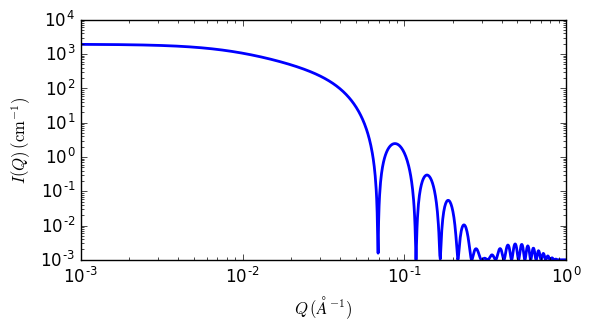fractal_core_shell
Scattering from a fractal structure formed from core shell spheres
| Parameter | Description | Units | Default value |
|---|---|---|---|
| scale | Source intensity | None | 1 |
| background | Source background | cm-1 | 0.001 |
| radius | Sphere core radius | Å | 60 |
| thickness | Sphere shell thickness | Å | 10 |
| sld_core | Sphere core scattering length density | 10-6Å-2 | 1 |
| sld_shell | Sphere shell scattering length density | 10-6Å-2 | 2 |
| sld_solvent | Solvent scattering length density | 10-6Å-2 | 3 |
| volfraction | Volume fraction of building block spheres | None | 1 |
| fractal_dim | Fractal dimension | None | 2 |
| cor_length | Correlation length of fractal-like aggregates | Å | 100 |
The returned value is scaled to units of cm-1 sr-1, absolute scale.
Definition Calculates the scattering from a fractal structure with a primary building block of core-shell spheres, as opposed to just homogeneous spheres in the fractal model. It is an extension of the well known Teixeira[1] fractal model replacing the \(P(q)\) of a solid sphere with that of a core-shell sphere. This model could find use for aggregates of coated particles, or aggregates of vesicles for example.
Where \(P(q)\) is the core-shell form factor and \(S(q)\) is the Teixeira[1] fractal structure factor both of which are given again below:
where \(\phi\) is the volume fraction of particles, \(V_s\) is the volume of the whole particle, \(V_c\) is the volume of the core, \(\rho_c\), \(\rho_s\), and \(\rho_{solv}\) are the scattering length densities of the core, shell, and solvent respectively, \(r_c\) and \(r_s\) are the radius of the core and the radius of the whole particle respectively, \(D_f\) is the fractal dimension, and ξ the correlation length.
Polydispersity of radius and thickness are also provided for.
This model does not allow for anisotropy and thus the 2D scattering intensity is calculated in the same way as 1D, where the \(q\) vector is defined as
Our model is derived from the form factor calculations implemented in IGOR macros by the NIST Center for Neutron Research[2]

Fig. 86 1D plot corresponding to the default parameters of the model.
References
| [1] | (1, 2) J Teixeira, J. Appl. Cryst., 21 (1988) 781-785 |
| [2] | S R Kline, J Appl. Cryst., 39 (2006) 895 |
Authorship and Verification
- Author: NIST IGOR/DANSE Date: pre 2010
- Last Modified by: Paul Butler and Paul Kienzle on: November 27, 2016
- Last Reviewed by: Paul Butler and Paul Kienzle on: November 27, 2016